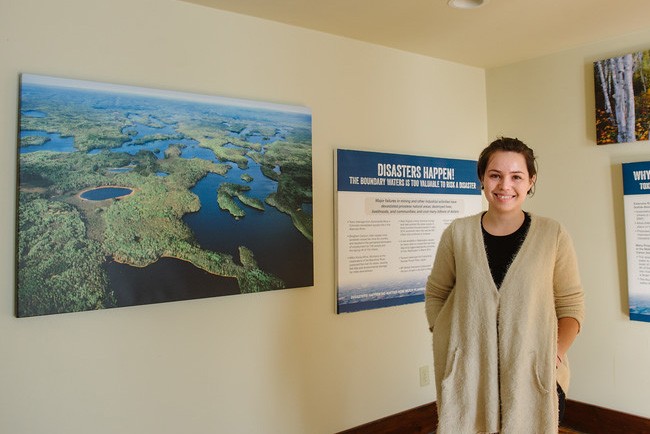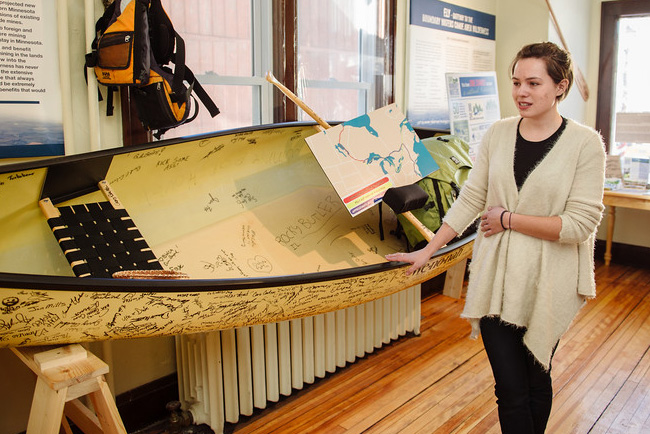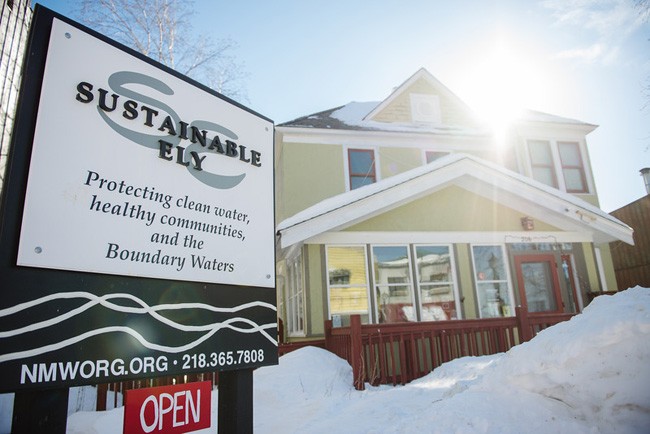
This story is sponsored by the Campaign to Save the Boundary Waters. It’s the second of a five-part series that will run on Heavy Table telling the story of Ely, its economy, and a special wilderness meal created by Chef J.D. Fratzke of The Strip Club Meat and Fish. Fratzke’s chef’s notebook from that meal runs this coming Monday.
The Boundary Waters Canoe Area is inextricably linked with the identity of Minnesota. That such a pristine and wild place exists a few hours from the metropolis of Minneapolis-St. Paul is one of the state’s unique calling cards, and anyone who has canoed across a placid lake and heard the calls of loons bounding across the water knows that the place is indescribably precious.
The potential advent of sulfide-ore copper mining — with its invariably destructive impact on nearby watersheds — threatens not just the Boundary Waters wilderness, but also the thriving and sustainable economy of tourism and telecommuting that sets towns like Ely apart from small towns that have been hollowed out by the boom-and-bust economic roller coaster of mineral extraction.
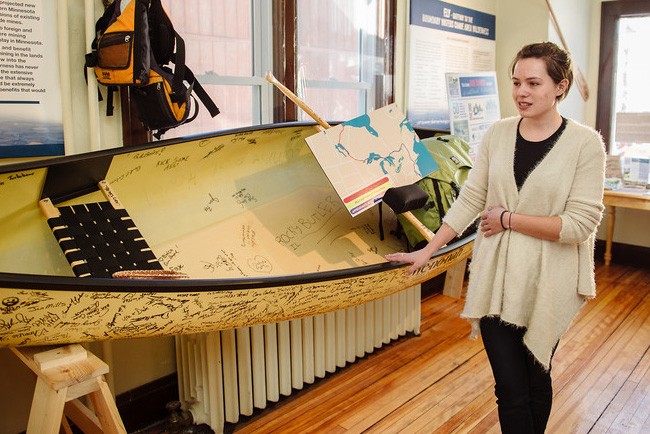
Residents of Northeastern Minnesota have banded together to protect the wilderness that makes their part of the world unique, by establishing Sustainable Ely. Part education center, part base for adventure activism, and part advocacy organization, Sustainable Ely operates out of a former residence on East Sheridan Street in the heart of downtown Ely. Staffed by interns and organizers like Olivia Ridge (above), the organization supports efforts such as a canoe trip from Ely to Washington, D.C. (undertaken by the team of Dave and Amy Freeman) and the signing of a petition to protect the Boundary Waters, dramatized by a signable petition canoe located in the group’s headquarters.
“Our mission is local outreach,” says Ridge. “We’re focused on the community of Ely and we’re the face of this issue in our town. We’ve also started a national movement, a campaign to save the Boundary Waters. We’re a coalition of more than 18 national and state-level organizations that have joined our cause and have agreed to work for the goal of no sulfide ore mining in the watershed of the Boundary Waters.”
Jane Koschak and her husband Steve own River Point Resort and Outfitting Company. River Point is located on a mile-long wilderness peninsula bordered by the South Kawishiwi River and Birch Lake, and it’s at the doorstep of the protected Boundary Waters. It’s also immediately proximate to a prospective mine site. The site’s owners began exploratory drilling in 2006, shattering the wilderness calm with a high-pitched grinding sound, which spurred Koschak and fellow community members into taking action.
How did the sound of drilling near River Point Resort spur the community effort that is Sustainable Ely?
JANE KOSCHAK: From 2006 on, mostly during the winter in the early years, these drill rigs would run 24/7, day after day after day. And this high-pitched grinding sound, this squealing sound of the drill rigs … you can just imagine the impact on our lives.
So we raised the alarm. We began to become very concerned. A year before last they did this exploratory drilling until the middle of July, so obviously it did impact our resort guests at that time.
Eventually we became more involved with other people who had the same feelings as us. There were five couples that came together — it will be two years ago on June 1, the actual founding of Sustainable Ely.
After a full year of meetings every week with these five couples, we eventually got together and created this wonderful facility on our main street in the heart of downtown Ely.
What’s the purpose of Sustainable Ely?
KOSCHAK: The mission statement of Sustainable Ely is protecting clean water and helping communities in the Boundary Waters. Basically, Sustainable Ely is our Ely education and outreach center to inform visitors and residents about the threat to our current sustainable economy. It also provides a platform for people and communities to communicate with their elected representatives.
We’ve done a lot of educational forums, a lot of outreach programs, we’ve brought in experts in economics, water quality, and advocacy groups to discuss the threat sulfide ore mining presents to our sustainable economy.
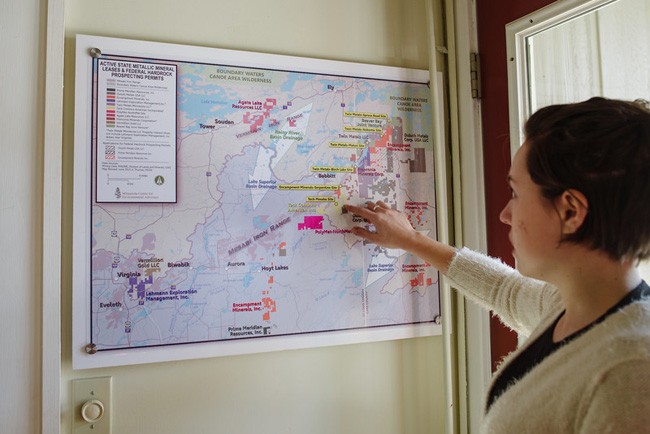
What, precisely, is that threat?
KOSCHAK: The EPA estimates that 40 percent of our watersheds in the Western US already are contaminated by pollution from hard rock — mostly sulfide ore — mining. The US Forest Service estimates there are now 10,000 miles’ worth of streams on Forest Service land that have been polluted by mining.
People figure, ‘How can it be that bad? We’ve had iron mining here on Minnesota’s Iron Range for 100-plus years, and we still have this, this, and this…’ But basically, when you mix water, air, and iron ore, you get rust. But when you mix water, air, and sulfide ore, you get sulfuric acid, which is basically like battery acid. That’s what will be pouring into the water in northern Minnesota if we were to have sulfide ore mining. That is highly toxic and corrosive.
What sort of economy already exists in Northeastern Minnesota, and how might mining disrupt or destroy it?
KOSCHAK: Northeastern Minnesota’s sustainable economy, which is the basis of family-owned businesses, is made up of a lot of vacation home owners, retirees … we have a lot of telecommuters, people who have computer-based businesses in their homes, but might be teaching classes in New York state.
We also have many wilderness travelers who come here, and resort visitors. All of us would not be able to survive the massive degradation of the natural landscape that comes with this type of mining. We would not be able to survive the loss of clean water due to toxic mine drainage that is the inevitable result of toxic ore mining; we wouldn’t be able to continue with our sustainable economy due to the loss of fresh air.
The question I ask is: Why would we turn our sustainable lakes district into another polluting mine district? Why would we allow the nation’s most toxic industry, which is hard rock sulfide mining, next to the nation’s most visited wilderness, the Boundary Waters, which is a priceless national treasure?
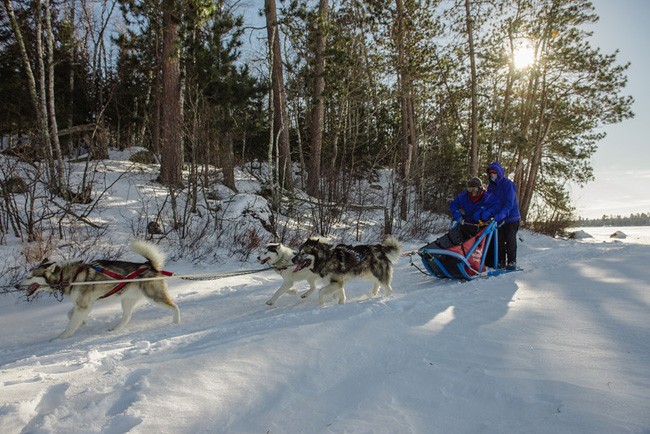
Give us a sense of the scope of the sustainable economy that already exists and is, in fact, growing.
KOSCHAK: Ely has 14 canoe-outfitting businesses, of which we are one. Seven cabin rental canoe-outfitting businesses. Eighteen resorts, of which we are one. The Boy Scouts Northern Tier Adventure Camp, the Girl Scouts Northern Lakes Canoe Base, four not-for-profit based businesses, four dogsledding adventure businesses … if you combine that with all the vacation and cabin retiree owners and other owners, that’s $318 million in tax value.
There are 400 people employed year-round by these businesses and another 600 employed in the summer months. Annually, the Wolf Center attracts 50,000 visitors, and the Bear Center attracts 30,000 visitors. That would all be lost because of the venture of Twin Metals.
How can people get involved to protect both the Boundary Waters and the Ely area’s sustainable economy…?
KOSCHAK: We want people to sign our online petition. The Campaign to Save the Boundary Waters has an online petition, so people can become engaged and learn more about what we’re doing.
